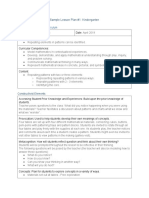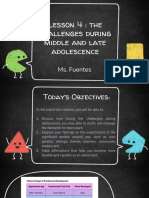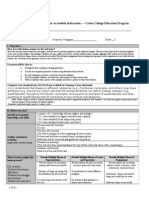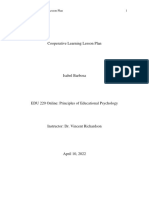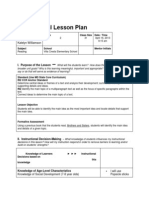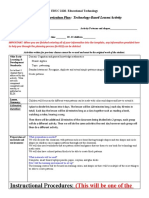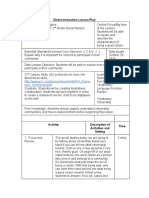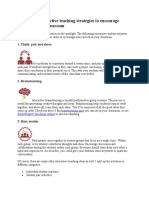Greedy Triangle Lesson Plan
Greedy Triangle Lesson Plan
Uploaded by
Lindsey MarieCopyright:
Available Formats
Greedy Triangle Lesson Plan
Greedy Triangle Lesson Plan
Uploaded by
Lindsey MarieCopyright
Available Formats
Share this document
Did you find this document useful?
Is this content inappropriate?
Copyright:
Available Formats
Greedy Triangle Lesson Plan
Greedy Triangle Lesson Plan
Uploaded by
Lindsey MarieCopyright:
Available Formats
Lindsey Hegenauer Professor Baldassarre Individual Lesson Plan March 28, 2013 Rationale: This lesson is being taught
to give students a better understanding of shapes and ways shapes are used in everyday life. This lesson is important because students will be able to create connections using visual aids. CCSS.Math.Content.K.G.B.6 Compose simple shapes to form larger shapes. For example, Can you join these two triangles with full sides touching to make a rectangle? Objective: Students will be able to compose simple shapes to form larger shapes. Students will understand how to correctly name each shape regardless of the orientation. Lesson Progression Turn on Smart Board and put lesson on board. (Book cover should be on the Smart Board) Today we are going to be reading the book, The Greedy Triangle. What do you think this book will be about? Ask: What are some basic shapes? As the story is read, create shapes on your Geo-board and I will draw the shapes on this Geo-board. Read the story (As a new shape is introduced draw on the Geo-board) After reading Now lets look at the shapes that were drawn on the board. Raise your hand if you know where the triangle is. How many sides does a triangle have? Now who wants to come up to the Smart Board and write the number 3 in the shape? Who can tell me, if I add one more side and one more angle what shape will I get? Complete activities on Smart Board Other Considerations: Materials: Smart Board Geo-Boards Rubber bands The Greedy Triangle Blank paper Crayons Markers Pencils Differentiation:
In order to accommodate different types of learners in the classroom, I will provide more direct instruction by either re-explaining the concepts to the students one on one or modeling a practice round of how to complete the tasks. I will also give student the option to play a game on the iPad that will help them understand shapes, or use manipulatives.
Perspective: Promote Higher Thinking: Students will develop an understanding of shapes from the book and the activities on the Smart Board. Through different activities students will be able to identify the name of each shape, the name of each shape, and the physical appearance of each shape. Students will than use this knowledge to find real life examples where shapes are seen in everyday life. Promotion of Student-Centered Learning: This lesson provides both individual and group understanding because students are working together during direct instruction and they are working individually to create their shapes drawing. Differentiation This lesson will accommodate different types of learners because of the diverse range of instruction. Students will be able to participate in various activities on the Smart Board that will help them understand shapes and connecting different shapes to everyday surroundings. Assessments: Students will participate in several activities on the Smart Board that will assess their understanding of each shape.
You might also like
- Sample Lesson Plan 1 Kindergarten MathematicsDocument3 pagesSample Lesson Plan 1 Kindergarten Mathematicsapi-452943700No ratings yet
- PD Lesson 4 Challenges of Middle and Late AdolescenceDocument20 pagesPD Lesson 4 Challenges of Middle and Late AdolescenceEL Fuentes100% (2)
- Apple Consumer BehaviourDocument3 pagesApple Consumer BehaviourRiya SachanNo ratings yet
- Observation 1 LessonDocument7 pagesObservation 1 Lessonapi-400989959No ratings yet
- Greedy TriangleDocument4 pagesGreedy TriangleSarah LombardiNo ratings yet
- Lesson Planning Form For Accessible Instruction - Calvin College Education ProgramDocument4 pagesLesson Planning Form For Accessible Instruction - Calvin College Education Programapi-300871680No ratings yet
- Dakota State University College of Education Lesson Plan FormatDocument4 pagesDakota State University College of Education Lesson Plan Formatapi-277836685No ratings yet
- Kagan PrimaryDocument4 pagesKagan PrimarygiannuzzvNo ratings yet
- Lessonplanspart 3Document35 pagesLessonplanspart 3api-247931703No ratings yet
- EDUC5271 Week 6 Written Assignment Unit 6Document6 pagesEDUC5271 Week 6 Written Assignment Unit 6Leisa GordonNo ratings yet
- Lesson 1 Rev JordynDocument7 pagesLesson 1 Rev Jordynapi-267077176No ratings yet
- Dakota State University College of Education Lesson Plan FormatDocument4 pagesDakota State University College of Education Lesson Plan Formatapi-277836685No ratings yet
- Sims PortfolioDocument24 pagesSims Portfolioapi-240050520No ratings yet
- Updated Lesson Plan Template ltc4240-2Document4 pagesUpdated Lesson Plan Template ltc4240-2api-340812362No ratings yet
- CuconstellationsDocument5 pagesCuconstellationsapi-318370664No ratings yet
- Stem Habits Through Literacy (Persistence) : Ccss - Ela-Literacy. Rl.1.1Document12 pagesStem Habits Through Literacy (Persistence) : Ccss - Ela-Literacy. Rl.1.1api-259478148No ratings yet
- ECE/Eled Required Lesson Plan FormatDocument2 pagesECE/Eled Required Lesson Plan Formatapi-286697548No ratings yet
- Mini LessonDocument2 pagesMini Lessonapi-338886620No ratings yet
- Lesson Plan For PresentationDocument4 pagesLesson Plan For Presentationapi-312376132No ratings yet
- Title of Lesson Grade Level Lesson Sources/ References: Ccss - Math.Content.2.G.A.1Document4 pagesTitle of Lesson Grade Level Lesson Sources/ References: Ccss - Math.Content.2.G.A.1api-313993232No ratings yet
- Big Ideas for Small Mathematicians: Kids Discovering the Beauty of Math with 22 Ready-to-Go ActivitiesFrom EverandBig Ideas for Small Mathematicians: Kids Discovering the Beauty of Math with 22 Ready-to-Go ActivitiesRating: 5 out of 5 stars5/5 (2)
- Edma3200 Lesson6practicumDocument2 pagesEdma3200 Lesson6practicumapi-252533855No ratings yet
- Mystery Shape Bag - Unit 5 Lesson GMDocument5 pagesMystery Shape Bag - Unit 5 Lesson GMapi-273593178No ratings yet
- ED 345 Calvin College UDL Lesson Plan Form: Ccss - Math.Content.6.G.A.2Document4 pagesED 345 Calvin College UDL Lesson Plan Form: Ccss - Math.Content.6.G.A.2api-300394682No ratings yet
- Cortneylollis Lesson5Document3 pagesCortneylollis Lesson5api-200969078No ratings yet
- Cooperative Learning Lesson Plan Edu 220 4-10-2022Document7 pagesCooperative Learning Lesson Plan Edu 220 4-10-2022api-570743058No ratings yet
- Fa23 Vts Video Analysis Jessica SandvigDocument3 pagesFa23 Vts Video Analysis Jessica Sandvigapi-706836589No ratings yet
- MathDocument3 pagesMathapi-273304946No ratings yet
- Math Centers Shape LessonDocument4 pagesMath Centers Shape LessonMarianne KassabianNo ratings yet
- Lesson: Lesson Plan #: 2 - Picture Gallery Lesson Overview: Being Able To Create An Accurate and Complete Diagram For ADocument5 pagesLesson: Lesson Plan #: 2 - Picture Gallery Lesson Overview: Being Able To Create An Accurate and Complete Diagram For Aapi-365767696No ratings yet
- Lesson Plan 4 Recalling DetailsDocument3 pagesLesson Plan 4 Recalling Detailsapi-177768681No ratings yet
- Ell Adapted Wants and Needs LessonDocument18 pagesEll Adapted Wants and Needs Lessonapi-298048835No ratings yet
- Lesson For Assignment 8Document3 pagesLesson For Assignment 8Madison BurgeiNo ratings yet
- 9196 Mccallie Day Unit 5 Mastery Mccallie 99970 594363050Document6 pages9196 Mccallie Day Unit 5 Mastery Mccallie 99970 594363050api-710208463No ratings yet
- Lesson Plan Geometry - Shapes.polygonsDocument3 pagesLesson Plan Geometry - Shapes.polygonsamypeabodyNo ratings yet
- Math Lesson 1Document4 pagesMath Lesson 1api-285781303No ratings yet
- Shapes Lesson PlanDocument10 pagesShapes Lesson Planapi-311345739No ratings yet
- Lesson Plan Subject Area/s Math Duration: How Rationale: Triangles, Squares, Rectangles, Circles, Hexagons, TrapezoidsDocument5 pagesLesson Plan Subject Area/s Math Duration: How Rationale: Triangles, Squares, Rectangles, Circles, Hexagons, Trapezoidsapi-586697387No ratings yet
- Math LP Shapes - Macro LessonDocument2 pagesMath LP Shapes - Macro Lessonapi-240696690No ratings yet
- Art Integration Lesson PlanDocument6 pagesArt Integration Lesson Planapi-332854373No ratings yet
- Lily's Lesson Plan TemplateDocument6 pagesLily's Lesson Plan TemplateLily BlackburnNo ratings yet
- Instructional Lesson PlanDocument8 pagesInstructional Lesson PlankyratheroseNo ratings yet
- (Complete Answers in Purple Font) : STEM 433/533 Lesson Planning TemplateDocument4 pages(Complete Answers in Purple Font) : STEM 433/533 Lesson Planning Templateapi-510369386No ratings yet
- Lesson Plan2 ISTCDocument4 pagesLesson Plan2 ISTCRachel FerrerNo ratings yet
- Contoh Cognitivism Lesson PlanDocument2 pagesContoh Cognitivism Lesson Planhadzarul100% (1)
- And What Is This Shape Called?: Common Core StandardsDocument4 pagesAnd What Is This Shape Called?: Common Core StandardsLauren HolschbachNo ratings yet
- Cardboard Project-2Document5 pagesCardboard Project-2api-613721337No ratings yet
- My Technology Lesson Plan.Document3 pagesMy Technology Lesson Plan.maria garciaNo ratings yet
- Ece 151 Mathexp 3 PDFDocument3 pagesEce 151 Mathexp 3 PDFapi-505851625No ratings yet
- BPT Lesson IdeaDocument5 pagesBPT Lesson Ideaapi-554061413No ratings yet
- Direct Instruction Lesson Plan: Work - Definitions PDFDocument5 pagesDirect Instruction Lesson Plan: Work - Definitions PDFapi-336817618No ratings yet
- Weaver Lessonplan-2-2Document2 pagesWeaver Lessonplan-2-2api-284252296No ratings yet
- Lesson Plan 1 Completed After GradedDocument4 pagesLesson Plan 1 Completed After Gradedapi-509223441No ratings yet
- Gianna Cordingley Mastery 5 229922 661285306Document7 pagesGianna Cordingley Mastery 5 229922 661285306api-665193969No ratings yet
- 3 Effective Interactive Teaching Strategies To Encourage Speech in Your ClassroomDocument6 pages3 Effective Interactive Teaching Strategies To Encourage Speech in Your Classroomcara villafuerteNo ratings yet
- 329 LP Math ObsDocument4 pages329 LP Math Obsapi-222110053No ratings yet
- Curriculum ArchiveDocument7 pagesCurriculum Archiveapi-208930981No ratings yet
- Technology 7,8Document6 pagesTechnology 7,8aydana2005No ratings yet
- Title of Lesson: The Area of Things Grade: 1 Mathematics Learning ObjectivesDocument4 pagesTitle of Lesson: The Area of Things Grade: 1 Mathematics Learning Objectivesapi-282373455No ratings yet
- Big BookDocument5 pagesBig Bookapi-302655079No ratings yet
- Resource in MathsDocument3 pagesResource in Mathsivan_ROY31087624No ratings yet
- Ed347 Original Curricul Design Progect PT 2Document11 pagesEd347 Original Curricul Design Progect PT 2api-722847247No ratings yet
- TDT S Schoolsurveytask RubricDocument3 pagesTDT S Schoolsurveytask RubricYulian CandraNo ratings yet
- PSW Psychosocial Assessment MainDocument4 pagesPSW Psychosocial Assessment MaintintuNo ratings yet
- Understanding by Design Lesson PlanDocument6 pagesUnderstanding by Design Lesson PlanNikkoOdejarNo ratings yet
- Multidisciplinary Discourses and PsychologyDocument173 pagesMultidisciplinary Discourses and PsychologykohinoorncmaipNo ratings yet
- Ineffective Breastfeeding NCPDocument6 pagesIneffective Breastfeeding NCPHarline GonzagaNo ratings yet
- Lincs StrategyDocument2 pagesLincs Strategyapi-396767767No ratings yet
- THUYẾT TRÌNH GIÁO DỤC ĐỊA PHƯƠNGDocument13 pagesTHUYẾT TRÌNH GIÁO DỤC ĐỊA PHƯƠNGvuongduong4577No ratings yet
- Psycho TheoriesDocument8 pagesPsycho TheoriessheffaliNo ratings yet
- Palagiang Talaan Sa Mababang Paaralan: (Elementary Schools Permanent Record)Document6 pagesPalagiang Talaan Sa Mababang Paaralan: (Elementary Schools Permanent Record)Karen Joyce Dela Cruz-BulabosNo ratings yet
- Introduction To Cultural Studies For PkbuDocument16 pagesIntroduction To Cultural Studies For PkbuTalayeh Ghofrani100% (1)
- Introduction To Psychology (PSY-101)Document21 pagesIntroduction To Psychology (PSY-101)Syed Ifran EjazNo ratings yet
- A Questionnaire On Vocabulary Teaching in ESL ClassesDocument2 pagesA Questionnaire On Vocabulary Teaching in ESL ClassesWallace Yang87% (15)
- Chapter 07 - Cross-Cultural Communication and NegotiationDocument34 pagesChapter 07 - Cross-Cultural Communication and Negotiationthang pstNo ratings yet
- Final Exam - Yarwin Yari - Transcultural Dialogic EncounterDocument11 pagesFinal Exam - Yarwin Yari - Transcultural Dialogic EncounterArdyawan Adry VjNo ratings yet
- Self Administered Questionnaire On Factors Influencing Suicidal Behavior ToolDocument7 pagesSelf Administered Questionnaire On Factors Influencing Suicidal Behavior ToolamitNo ratings yet
- Corrected Chapter 1Document38 pagesCorrected Chapter 1Pines MacapagalNo ratings yet
- Memory Reconsolidation Applied by Lars ClausenDocument25 pagesMemory Reconsolidation Applied by Lars Clausentimsmith108157450% (2)
- ENFJ Veteran PDFDocument62 pagesENFJ Veteran PDFMirka Ivanova100% (2)
- Mauthner's "Critique of Language" - A Forgotten Book at The "Wake"Document22 pagesMauthner's "Critique of Language" - A Forgotten Book at The "Wake"Madhumoni DasguptaNo ratings yet
- 4-7-16 Ict Lesson PlanDocument11 pages4-7-16 Ict Lesson PlanSreebu BahuleyanNo ratings yet
- LEAD Self - InstrumentDocument5 pagesLEAD Self - Instrumentfirasjordan5No ratings yet
- Healing Spaces Elements of Environmental Design That Make An Impact On Health PDFDocument14 pagesHealing Spaces Elements of Environmental Design That Make An Impact On Health PDFCaesarC100% (1)
- Zip Zap ZoomDocument4 pagesZip Zap ZoomIvan Teh RunningManNo ratings yet
- 09 Chapter3Document50 pages09 Chapter3Reza ShirmarzNo ratings yet
- Child-Centred Curriculum Planning (0-5 Years) : Self-Guided Learning PackageDocument20 pagesChild-Centred Curriculum Planning (0-5 Years) : Self-Guided Learning PackageawanderersoulNo ratings yet
- Concept of Essay TestDocument3 pagesConcept of Essay TestNafeesa FatimaNo ratings yet
- Spikeball Unit Plan March 23 - April 2 1Document8 pagesSpikeball Unit Plan March 23 - April 2 1api-507047686No ratings yet
- Httpwijamw17.Ce - Student.pens - Ac.idenglish205job Hunting PDFDocument113 pagesHttpwijamw17.Ce - Student.pens - Ac.idenglish205job Hunting PDFolgaNo ratings yet
